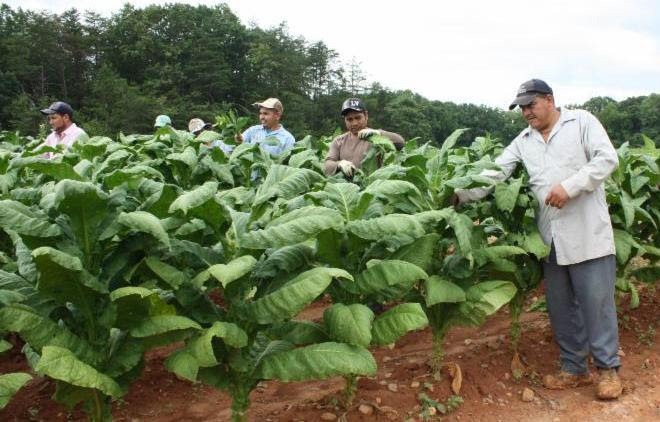
The best of a bad-looking crop: Rob Glover of Bailey, N.C. stands in his best tobacco field on July 17. A hot dry summer has left much of the U.S. flue-cured crop in poor condition, but enough rain could still rescue it. You can see this field at the N.C. Organic Cropping Systems Field Day on July 23, beginning at Bailey. See below for details and for some of Glover's experiences growing organic.
|
USDA released its first estimate of 2018 tobacco production on July 12, based on early June surveying. The estimate covered flue-cured only and forecast this season's production at 432 million pounds, down six percent from 2017. Acreage was estimated at 204,500 acres, two percent below last year, while yield per acre was forecast at 2,111 pounds, down 88 pounds from a year ago. The majority of the crop was rated in good to fair condition. USDA said.
Among the individual states, USDA estimated production at: NC--down 7.5 percent at 331.8 million pounds. VA--down 4.3 percent at 48.4 million pounds. GA-no change at 26.25 million pounds change. SC--no change at 25.2 million pounds.
Progress reports from Extension workers in individual states.
NORTH CAROLINA (Flue): The crop in eastern North Carolina has been through a lot, thanks to a wet early-season and a prolonged hot, dry spell over the past month," says Matthew Vann, N.C. Extension tobacco specialist. "We got some rain in places on July 17 and may get a little more Friday or Saturday. Every milliliter will be needed, and we need more."The lower stalk leaf is firing up fast east of Raleigh. "Farmers are hustling to get the lower stalk leaf off the stalk as soon as they can," Vann says. "You see farmers knocking off their bottom leaves with leaf removal equipment."That's probably a good idea. "Leaves grown under the conditions we've had could present market-ing challenges," One of the worst things about the weather in the Coastal Plain this year is that the transition from wet to extremely hot and dry took place almost overnight, Vann says.
NORTH CAROLINA (Burley): In the N.C. mountains, scattered thunderstorms brought significant rainfall to parts of the county the week ending on the July 15. But other parts remained dry. "There was some localized flash flooding," says Stanley Holloway, Yancey County Extension agent. "However, little to no crop damage occurred." Overall, the burley crop is looking pretty good, he says. But black shank is showing up in a few fields.
TENNESSEE: The dry spell has been less severe in much of east Tennessee than in N.C., says Don Fowlkes, manager of agronomy, Burley Stabilization Corporation. "We have been dry for the most part, but the crop has held on pretty well. Most--though not all--of the areasthat needed rain got it this week. The stand is not as good or as uniform as we would like but it is acceptable." The crop was late set, and the June heat made for stand losses and more resetting than normal. Now some is approaching topping. Fowlkes hopes topping will get done on time. On a crop like this, that will be important, he says. Farmers in east Tennessee appear to have reduced plant populations, he says. "The goal is to try to produce more red and reddish leaf."
VIRGINIA: In Appomattox County in the central district, farmers are hopeful for rain. "Tobacco farmers continue to work on weed control, and many will be topping by the middle to end of the week," says Bruce Jones, county Extension agent. "Irrigation will start on tobacco as well if rainfall is not received." In the southeast, Brunswick Extension agent Cynthia Gregg says flue-cured tobacco is being pulled and cured now. "We are in need of rain." In southern Virginia, Pittsylvania Extension agent Stephen Barts says drought conditions continue to worsen, and row crops are suffering in the high heat conditions.
OTHER STATES: In South Carolina, 60 percent of the crop is topped and 10 percent is harvested. In Georgia, 92 percent is topped and 35 percent is harvested. In Kentucky, 12 percent is topped and 33 percent is blooming.
What's the one indispensable step to take when you start out in organic tobacco? "Make sure you have enough organic land for rotation," says Rob Glover, who farms in Bailey, N.C. That can be a real challenge, but Glover has found enough suitable land for his 40 acres of organic as well as 40 of PRC. He rotates tobacco with fescue and wheat, sweet potatoes, and wheat and soybeans. "Fescue fits in well behind tobacco," says Glover, who grew his first organic tobacco in 2012.
DATES TO REMEMBER:
N.C. State will host two tobacco events in three consecutive days later this month. The first will be an:
*Note: Hotels are available in North Raleigh (Crabtree Valley Mall area) and Oxford (I-85/Hwy 96 area) for those intending to stay in the area. Hotel blocks will not be reserved by NCSU.
|


 ilson County Elks Lodge, 2814 Fieldstream Dr., Wilson, N.C. A cash bar will be open from 5:30 to 6 p.m., with food served around 6 p.m.
ilson County Elks Lodge, 2814 Fieldstream Dr., Wilson, N.C. A cash bar will be open from 5:30 to 6 p.m., with food served around 6 p.m. 





